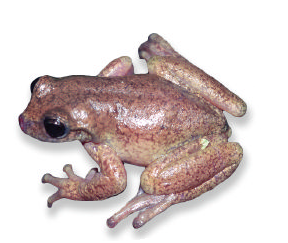Sarcohyla arborescandens is a species of frog in the family Hylidae. It is endemic to Mexico. Its natural habitats are subtropical or tropical moist montane forests and rivers. It is threatened by habitat loss.

Sarcohyla bistincta, also known as the Mexican fringe-limbed treefrog or Cope's streamside treefrog, is a species of frog in the family Hylidae. It is endemic to Mexico; it is widespread and occurs from southern Sinaloa and Durango southeastward to Veracruz and Oaxaca. The nominal Sarcohyla bistincta consists of several lineages that may eventually be described as distinct species.
Sarcohyla calvicollina is a species of frog in the family Hylidae. It is endemic to Mexico. Its natural habitats are subtropical or tropical moist montane forests and rivers. It is threatened by habitat loss.
Sarcohyla celata, also known as the Oaxaca treefrog, is a species of frog in the family Hylidae. It is endemic to Mexico and only known from the Sierra de Juárez in northern Oaxaca. After having not been seen after 1984, it was feared that the species might be extinct. However, the species was rediscovered in field surveys during 2011–2014 and some subpopulations are at healthy levels.
Sarcohyla charadricola is a species of frogs in the family Hylidae.
Sarcohyla chryses, also known as the golden treefrog, is a species of frog in the family Hylidae. It is endemic to the Sierra Madre del Sur in Guerrero, Mexico. Its sister species is Sarcohyla mykter.
Sarcohyla crassa is a species of frog in the family Hylidae. It is endemic to the Sierra Madre de Oaxaca of Oaxaca, Mexico. It is also known as the aquatic treefrog, or when referring to the former Hyla bogertae, Bogert's aquatic treefrog.
Sarcohyla cyclada is a species of frog in the family Hylidae. It is endemic to the Sierra Madre de Oaxaca of Mexico.
Plectrohyla hazelae is a species of frog in the family Hylidae. It is endemic to Mexico. Its natural habitats are subtropical or tropical moist montane forests and rivers. Scientists have seen it in pine-oak forests, in cloud forests, and in other mountain forests. It has been observed between 1,461 and 2,128 meters above sea level.

Sarcohyla mykter, also known as the keelsnout treefrog or keel-snouted treefrog, is a species of frog in the family Hylidae. It is endemic to the Sierra Madre del Sur in Guerrero, Mexico. Its sister species is Sarcohyla chryses.
Sarcohyla pachyderma is a species of frog in the family Hylidae. It is endemic to Mexico. Its natural habitats are subtropical or tropical moist montane forests. Scientists know it from a single stream on the eastern side of the Sierra Madre mountains in Veracruz, 1600 meters above sea level.
Sarcohyla pentheter, the mourning treefrog, is a species of frog in the family Hylidae. It is endemic to Mexico. Its natural habitats are subtropical or tropical moist montane forests and rivers. Scientists have observed it pine-oak forests on the west side of the Sierra Madre del Sur mountains in Oaxaca between 1,280 and 2,000 meters above sea level.
Sarcohyla psarosema is a species of frogs in the family Hylidae.
Sarcohyla robertsorum is a species of frog in the family Hylidae. It is endemic to Mexico. Its natural habitats are subtropical or tropical moist montane forests and rivers. It has been observed between 2250 and 3050 meters above sea level. It is threatened by habitat loss.
Sarcohyla sabrina, also known as the Sierra Juarez treefrog, is a species of frog in the family Hylidae. It is endemic to the northern slopes of Sierra de Juárez in northern Oaxaca, Mexico. The specific name sabrina is Latin for river nymph and refers to the close association of this species with streams.
Sarcohyla siopela, also known as the voiceless treefrog or mute treefrog, is a species of frog in the family Hylidae. It is endemic to Mexico and only known from the west slope of the Cofre de Perote Mountain, in Sierra Madre Oriental, central Veracruz. It is feared that the species might be extinct.
Sarcohyla thorectes, commonly known as Adler's mottled tree frog, a species of frog in the family Hylidae. It is endemic to Mexico. Its natural habitats are subtropical or tropical moist montane forests and rivers. It has been observed in streams between 1530 and 1900 meters above sea level in the Sierra Madre mountains. It is threatened by habitat loss.
Sarcohyla miahuatlanensis, or the Sierra Miahuatlan spikethumb frog, is a species of frog in the family Hylidae. It is endemic to Mexico and only known from its type locality near Candelaria Loxicha on the Sierra de Miahuatlán in Oaxaca.
Sarcohyla toyota, or Toyota's tree frog is a frog in the family Hylidae, endemic to Mexico. Scientists have seen it in cloud forests in the Sierra Madre del Sur mountains between 1975 and 2185 meters above sea level.
Sarcohyla floresi is a frog in the family Hylidae, endemic to Mexico. Scientists have seen it between 1461 and 2000 meters above sea level.


